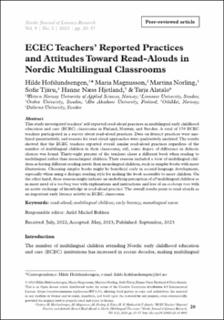ECEC Teachers’ Reported Practices and Attitudes Toward Read-Alouds in Nordic Multilingual Classrooms
Hofslundsengen, Hilde Christine; Magnusson, Maria; Norling, Martina; Tjäru, Sofie; Hjetland, Hanne Næss; Alatalo, Tarja
Peer reviewed, Journal article
Published version
Permanent lenke
https://hdl.handle.net/11250/3107737Utgivelsesdato
2023Metadata
Vis full innførselSamlinger
Originalversjon
10.23865/njlr.v9.4035Sammendrag
This study investigated teachers’ self-reported read-aloud practices in multilingual early childhood education and care (ECEC) classrooms in Finland, Norway, and Sweden. A total of 170 ECEC teachers participated in a survey about read-aloud practices. Data on literacy practices were analyzed quantitatively, and reasons for read-aloud approaches were qualitatively analyzed. The results showed that the ECEC teachers reported overall similar read-aloud practices regardless of the number of multilingual children in their classrooms; still, some degree of difference in didactic choices was found. Thirty-eight percent of the teachers chose a different book when reading to multilingual rather than monolingual children. Their reasons included a view of multilingual children as having different reading needs than monolingual children, such as simpler books with more illustrations. Choosing simpler books might be beneficial early in second-language development, especially when using a dialogic reading style for making the book accessible to more children. On the other hand, these reasons might indicate an underlying perception of all multilingual children as in more need of a teaching tone with explanations and instructions and less of an exchange tone with an active exchange of knowledge in read-aloud practice. The overall results point to read-alouds as an important early literacy activity in ECEC classrooms.

